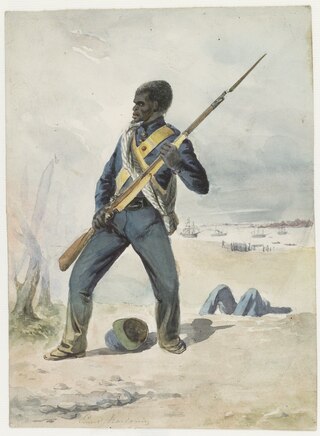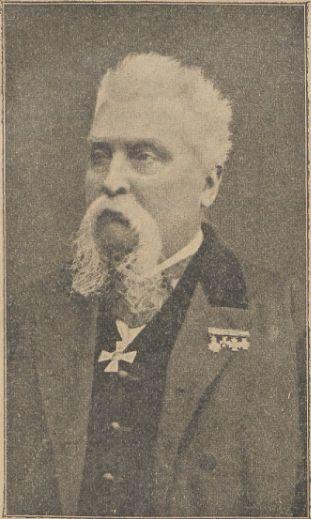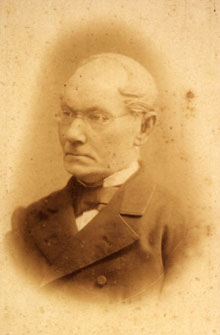
The Royal Netherlands East Indies Army was the military force maintained by the Kingdom of the Netherlands in its colony of the Dutch East Indies, in areas that are now part of Indonesia. The KNIL's air arm was the Royal Netherlands East Indies Army Air Force. Elements of the Royal Netherlands Navy and Government Navy were also stationed in the Netherlands East Indies.

Herman Willem Daendels was a Dutch revolutionary, military leader, and statesman. He was 36th Governor General of the Dutch East Indies, a position he held from 1808 to 1811.
Kwaku Dua Panin was the eighth Asantehene of the Ashanti Empire from 25 August 1834 until his death.

The Dutch Gold Coast or Dutch Guinea, officially Dutch possessions on the Coast of Guinea was a portion of contemporary Ghana that was gradually colonized by the Dutch, beginning in 1612. The Dutch began trading in the area around 1598, joining the Portuguese which had a trading post there since the late 1400s. Eventually, the Dutch Gold Coast became the most important Dutch colony in West Africa after Fort Elmina was captured from the Portuguese in 1637, but fell into disarray after the abolition of the slave trade in the early 19th century. On 6 April 1872, the Dutch Gold Coast was, in accordance with the Anglo-Dutch Treaties of 1870–71, ceded to the United Kingdom.

Belanda Hitam was an Indonesian language term used to refer to Black soldiers recruited by the Dutch colonial empire for service in the Royal Netherlands East Indies Army (KNIL), the colonial army of the Dutch East Indies. The recruitment of Black soldiers into the KNIL resulted from a combination of factors, including the heavy losses suffered by Dutch forces in the Java War and concerns over the reliability of indigenous KNIL troops. Between 1831 and 1872, over 3,000 West Africans, mostly Akan people, were recruited from the Dutch Gold Coast for KNIL service in the East Indies.

Cornelis Johannes Marius Nagtglas was a Dutch politician and civil servant, who made a career in the administration on the Dutch Gold Coast. After originally beginning his career at the advanced age of 36, he was promoted through the ranks to eventually become Governor of the Dutch Gold Coast in 1858. He retired to the Netherlands in 1862, but returned to the Gold Coast as governor in 1869, to restore order in the embattled colony. In 1871, he left the Gold Coast again, one year before the transfer of the colony to the United Kingdom.
Jacob Peter Huydecoper was an early 19th-century Elmina Euro-African civil servant and diplomat on the Dutch Gold Coast.
David van Nyendael, also van Nijendael, was a Dutch merchant and diplomat in the service of the Dutch West India Company, and stationed at the Dutch Gold Coast.

Asafo are traditional warrior groups in Akan culture, based on lineal descent. The word derives from sa, meaning war, and fo, meaning people. The traditional role of the Asafo companies was defence of the state. As the result of contact with European colonial powers on the Gold Coast, the Fante, who inhabit the coastal region, developed an especially complex version of the concept in terms of its social and political organization based on martial principles, and with elaborate traditions of visual art, including flag banners with figurative scenes, and designs alluding to historical events or proverbs.
The Dutch–Ahanta War was a conflict between the Netherlands and the Ahanta between 1837 and 1839. Beginning with a mere economic dispute between the Ahanta and the Dutch, who were based at the Dutch Gold Coast, the conflict ended with the hanging of Ahanta king Badu Bonsu II and the reorganization of the Ahanta state, establishing a Dutch protectorate over the Ahanta.

Willem George Frederik Derx was a Dutch civil servant, who made a career in the administration on the Dutch Gold Coast.
The Kingdom of the Netherlands has an embassy in the Republic of Ghana. It has a role in promoting trade between the countries.
Pieter Simon Hamel was a Dutch diplomat who served as Consul General at Elmina, Bangkok and Amoy.
Willem Pieter Antonie Le Jeune, born as Willem Pieter Antonie Tenwinkel, was a Dutch colonial administrator and diplomat, who made a career in the administration on the Dutch Gold Coast and who was interim governor between 28 October 1871 and 15 November 1871. After the Netherlands sold its possessions on the Gold Coast to the United Kingdom in 1872, Le Jeune became the first Dutch consul in Elmina.
Hendrik Severinus Pel was a Dutch zoologist and colonial administrator on the Dutch Gold Coast.

Jan Kooi was a Dutch KNIL military officer from Ghana.
Friedrich Franz Ludwich Ulrich Last was a colonial administrator on the Gold Coast.

Kobina Gyan was king or ohin of Elmina (Edinahene) between 1868 and 1873 and between 1894 and his death in 1896. Between 1873 and 1894, Kobina Gyan was exiled by the British colonial authorities for his pro-Dutch and anti-British position.

The documented history of Elmina begins in 1482 with an agreement between the Portuguese navigator Diogo de Azambuja and the ruler of Elmina, called Caramansa by the Portuguese. In it, the Portuguese were allowed to build the first European fortress in sub-Saharan Africa. For the next 150 years until the conquest by the Dutch in 1637, Elmina was the capital of the Portuguese bases on the Gold Coast, then for about 250 years the capital of the Dutch Empire in West Africa. Since the capture of the lease for the two fortresses of Elmina by the Ashanti in 1701, the city was also important to the Ashanti Empire. Until the 19th century, Elmina was one of the most populous cities in the Gold Coast, surpassing Accra and Kumasi. The trade in gold, slaves and palm oil brought the city into direct contact with Europe, North America, Brazil and, through the recruitment of soldiers, also with Southeast Asia. It was not until the takeover and destruction of the city by the British in 1873 that Elmina lost its prominent position in the Gold Coast.
Hubertus Varlet was a Dutch architect and colonial administrator, who served on the Dutch Gold Coast. In his capacity as master of works and stores, he rebuilt Fort Crèvecoeur in Accra in 1839. Following the promotion of Anthony van der Eb to governor of the Dutch Gold Coast, Varlet succeeded him as the second vice governor for the Ahanta protectorate, which the Dutch had proclaimed following the conclusion of the Dutch–Ahanta War.












